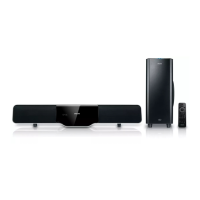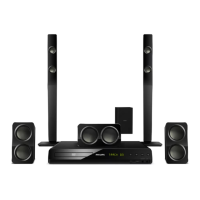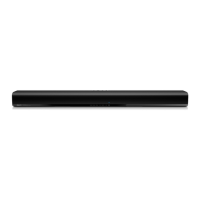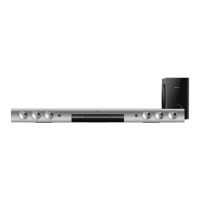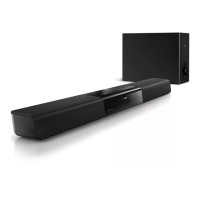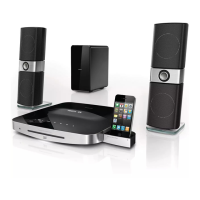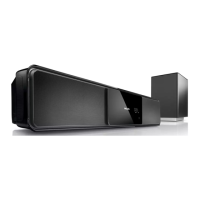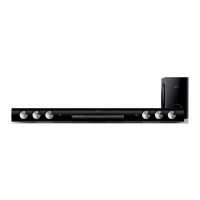
Do you have a question about the Philips HSB2313/12 and is the answer not in the manual?
| Number of speakers | 2.1 |
|---|---|
| Subwoofer | Yes |
| Subwoofer Power | 60W |
| Bluetooth | Yes |
| HDMI | No |
| USB Playback | Yes |
| Frequency Response | 40Hz - 20kHz |
| Input Impedance | 10kΩ |
| Total Power Output | 120W |
| Satellite Speaker Power | 30W each |
| Audio Input | 3.5mm, RCA |
| Type | Home Cinema speakers |
Read and understand all instructions before use. Follow safety guidelines to prevent damage and warranty voidance.
Explanation of safety symbols like CAUTION and WARNING for product use and electrical safety.
Overview of the home theater system's capabilities and benefits for users.
List of all included components and accessories with the home theater system package.
Includes sound settings, power, USB, AV/MP3 link, and volume controls.
Ports for audio inputs (Optical, Coaxial, AV1/AV2), HDMI, subwoofer out, and DC power.
Buttons for selecting sources, navigation, play/pause, and volume adjustments.
Buttons for sound modes, clock, display, setup, and timer functions.
Includes power, mute, subwoofer volume, audio sync, and program/repeat functions.
Warning about unsafe operation and details needed when contacting Philips for support.
Instructions for physically connecting the speakers and mounting the unit stand.
Guides for connecting TVs using coaxial, AV, or SCART cables.
Instructions for connecting a DVD player to the system and TV for audio playback.
Instructions for connecting a game console to the system via AV or MP3 Link.
Instructions for connecting HDMI-compliant devices for high-definition audio and video.
Instructions for connecting digital coaxial audio sources to the system.
Warnings about voltage correspondence and safe unplugging practices for the power cord.
Instructions for connecting the power plug to the DC IN and SUBWOOFER OUT sockets.
Warnings about battery handling, explosion risk, and proper insertion.
Step-by-step guide for opening the compartment and inserting AAA batteries correctly.
How to turn on the unit, switch to standby, or Eco Power Standby modes.
How to enter the clock setting mode from standby by pressing CLOCK.
Using VOL +/- buttons to set the hour and minute, and CLOCK to confirm.
Explanation of EasyLink (HDMI CEC) for controlling multiple devices with one remote.
Instructions for turning Easylink On and Off using the SETUP button.
Instructions for playing music files from a connected USB device.
How to activate and deactivate random playback and select repeat modes for tracks.
Instructions for arranging and playing tracks in a specific programmed order.
How to select and play audio from connected AV sources like TVs or DVD players.
How to increase or decrease the main volume and subwoofer volume.
Options for equalizer, game, movie sound effects, and audio sync.
How to mute or unmute the audio output using the MUTE button.
Instructions for setting the system to turn on automatically at a specific time.
How to set the system to automatically turn off after a specified period.
Details on amplifier, speaker, general specs, and AC power consumption.
Information on compatible USB devices and details on supported and unsupported file formats.
Important warnings against opening the unit and guidance on seeking service from Philips.
Troubleshooting steps for no power, no sound, and HDMI audio/video problems.
Tips for fixing remote control problems and handling incompatible USB devices or files.
Steps to resolve issues with picture on HDMI connections, checking cables and compliance.
Instructions and cautions for securely mounting the main unit and speakers onto a wall.
List of items included in the wall mounting kit, such as bracket and screws.
List of tools needed for wall mounting, including electric drill, screwdriver, and pencil.
Step-by-step guide for aligning the bracket, drilling holes, and securing the unit to the wall.


